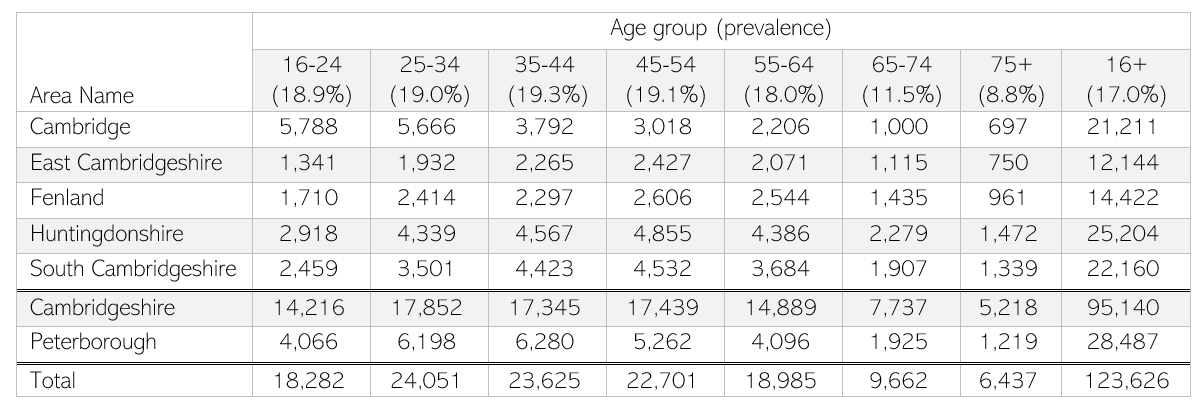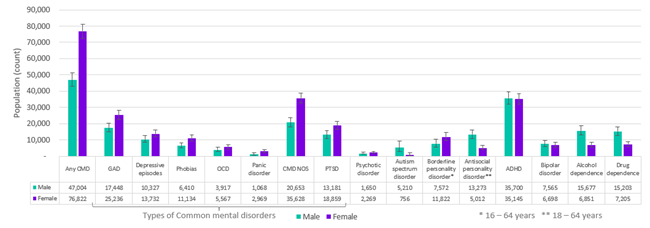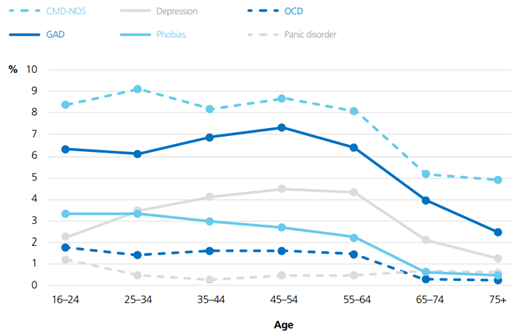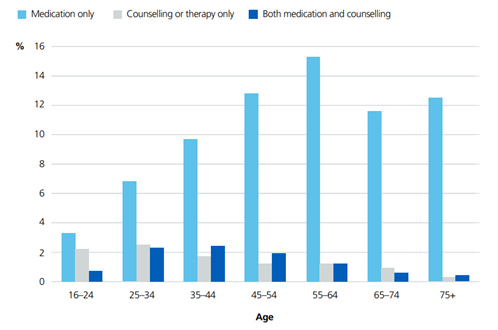Estimated prevalence
- It is estimated that around 123,500 people experienced a common mental health condition within the past week in Cambridgeshire and Peterborough (table below).
- Chapter two of this mental health needs assessment covers population groups at higher risk of poor mental health.
- The estimated prevalence of adverse childhood experiences is covered in chapter four of the mental health needs assessment.
Common mental health conditions
- The estimated prevalence of mental illness in Cambridgeshire and Peterborough were calculated using the Adult Psychiatric Morbidity Survey (APMS). This survey provides data on the prevalence of both treated and untreated psychiatric disorders in the English adult population (aged 16) using actual diagnostic criteria for a range of conditions.
- The national prevalence data from the APMS carried out in 2014 has been applied to the Census 2021 population for Cambridgeshire, Peterborough and the five districts to calculate the local estimated population size with different mental illnesses by age and sex. The actual prevalence will be affected by random variation and also by local variations in risk factors such as deprivation.
- It is estimated that around 123,500 people experienced a common mental health condition within the past week in Cambridgeshire and Peterborough.
- About 43,000 are estimated to have experiences some form of anxiety disorder and 24,000 to have experienced depression.
Figure 10: Estimated number of people with common mental health conditions, substance dependence, ADHD and autism in the Cambridgeshire and Peterborough (aged 16+). Data sources: Adult Psychiatric Morbidity Survey (2014), Census 2021
Estimates have also been calculated by district, which show that Peterborough and Huntingdonshire have the highest estimated numbers of adults (aged 16+) with common mental health conditions. These estimates are based on national surveys so do not adjust for local factors such as differences in deprivation between areas.
Table 4: Estimated prevalence of any common mental health condition in Cambridgeshire and Peterborough districts, by age group. Data sources: APMS and Census 2021
For further breakdown by type of mental health condition, see the slides below.
It is important to consider that many people meet criteria for more than one mental health condition (NHS Digital, 2014), and may have other co-occurring needs. For example, people who experience psychosis are more likely than the general population to have a have a history of trauma, poor physical health and social issues (National Institute for Health and Care Excellence et al., 2016). Around 40% of people with first-episode psychosis will misuse substances at some point in their lifetime (National Institute for Health and Care Excellence et al., 2016).
Prevalence by age
The Adult Psychiatric Morbidity Survey (2014) showed that working-age adults (aged 16 to 64) were around twice as likely to have symptoms of common mental health conditions that adults over 65. Anxiety disorders were more common in young women aged 16 to 24, compared to other groups.
Figure 11: Prevalence of common mental disorders (CMDs), by age. Image source: Adult Psychiatric Morbidity Survey 2014. Note: CMD-NOS is ‘common mental disorder – not otherwise specified’, indicating where people had a CIS-R (clinical interview) score of 12+ but did not meet criteria for any specific condition. OCD is obsessive-compulsive disorder, and GAD is generalised anxiety disorder.
The Adult Psychiatric Morbidity Survey also showed that adults aged between 35 and 54 were most likely to receive treatment for a mental health condition, after controlling for the severity of symptoms; whilst young adults (aged 16 to 25) and adults aged 75 or over were the least likely to receive treatment. Young adults (16 – 24) were the least likely to use psychotropic medication. Adults aged 75 or over were 10 times more likely to receive medication than psychological therapy, despite being at greater risk of medication side effects.
Figure 12: Proportion of adults receiving treatment for a mental health condition, by age. Image source: Adult Psychiatric Morbidity Survey 2014
Who is most likely to experience common mental health conditions?
- The prevalence of common mental health problems is influenced by the wider determinants of health. For example, people living in poverty are more likely they are to have some form of mental health problem. Poor mental health can also lead to reduced income and employment, which entrenches poverty and increases the risk of mental health problems (Public Health England, 2019).
- Data from the national Adult Psychiatric Morbidity Survey (2014) found that Black women, adults under the age of 60 who lived alone, women living in large households, adults who smoke and adults in receipt of benefits were most likely to have common mental health conditions (NHS Digital, 2014).
- Chapter two of this mental health needs assessment covers population groups at higher risk of poor mental health.
Psychosis
PsyMaptic is a population-level prediction model that predicts the number of people experiencing first-episode psychosis; and those referred, assessed and treated by Early Intervention in Psychosis (EIP) services, based on epidemiological evidence and demographic predictions (McDonald et al., 2021). The local EIP service is CAMEO.
Using this tool, we can estimate that there were 371 people (95% confidence interval: 343 – 401) who would meet the threshold to be referred to CAMEO in 2023 for suspected psychosis, and 137 people (95% confidence interval: 127 – 148) who we would expect to meet the full ICD-10 criteria for a first-episode of a psychotic disorder in 2023.
Impact of the COVID-19 pandemic and cost of living crisis
The impact that the COVID-19 pandemic will have on mental health is not fully understood. Considerations should be made for direct impacts on arising from COVID-19 infection, alongside indirect effects arising from lockdown and social isolation, disruptions to normal patterns and routines, and economic pressures (Davidson, 2021).
- The Centre for Mental Health estimates that 5 million additional adults in England will require mental health support from 2021 to 2026, as a direct result of the COVID-19 pandemic (O’Shea, 2021).
- National surveys show that there were increases in poor mental health over the pandemic, particularly during periods of national lockdowns and high rates of COVID-19 cases, including anxiety, depressive symptoms and stress (Office for Health Improvement and Disparities, 2022a). Groups most at risk of poor mental health during the early stages of the pandemic included ‘young adults, women, those with pre-existing mental health conditions, those from minority ethnic communities, and people experiencing socio-economic disadvantage’ (Bunn & Dias, 2021).
- Data suggests that although adults with pre-existing mental health conditions reported poorer mental health and wellbeing in the earlier stages of the pandemic than those without, this gap did not widen over this time (Office for Health Improvement and Disparities, 2021).
- There is some evidence suggesting that rural communities may have faced specific pressures on mental health as a result of the COVID-19 pandemic, alongside other impacts such as from Brexit (Environment Food and Rural Affairs Committee, 2023).
Evidence shows that the cost of living crisis is likely to be impacting the nation’s mental health:
- 1 in 6 adults experienced moderate to severe depressive symptoms in autumn 2022, similar to rates in summer 2021 but higher than pre-pandemic levels (Office for National Statistics, 2022).
- Although there is not enough evidence to provide levels of depressive symptoms were higher due to the rising cost of living, rates of people with depressive symptoms were almost 3 times higher amongst people who reported finding it ‘difficult’ to pay their energy bills, compared to those who found it ‘easy’ (Office for National Statistics, 2022).
Additional resources
- Time for united action on depression: a Lancet–World Psychiatric Association Commission
- Depression and Other Common Mental Disorders: Global Health Estimates
- Covid-19 and the nation’s mental health, Mental health impacts of the COVID-19 pandemic on adults and COVID-19 mental health and wellbeing surveillance: report
- Mental Health and the Cost-of-living Crisis: Another pandemic in the making?
- A significant proportion of mental health conditions begin in childhood (50% by age 14) and the majority by young adulthood (75% by age 25). There are close links to the chapter on children and young people’s mental health, which includes a focus on the transition between children and young people’s services.
- Whilst there will also be a chapter on this needs assessment focusing on the mental health needs of older adults, it is important to consider the all-age adult aspects for this population.
References
Full list of references is included at the end of this chapter.




